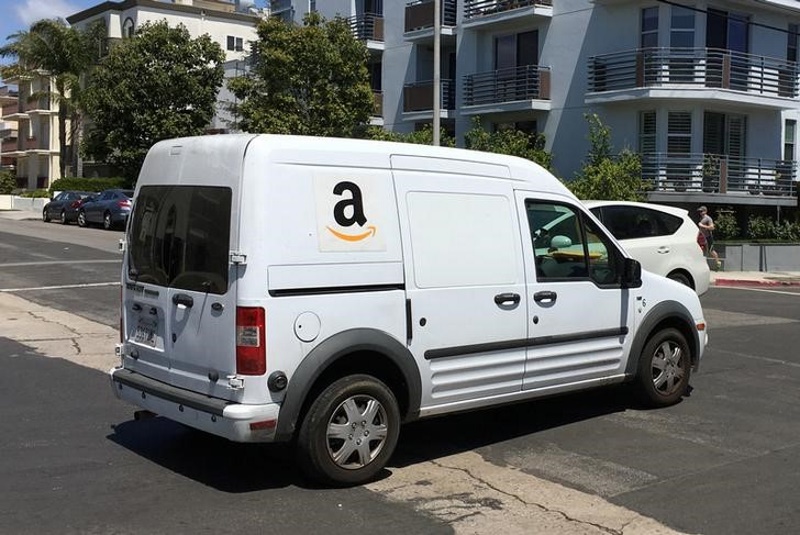- Home
- Internet
- Internet News
- Amazon's Already Large Distribution Empire Keeps Expanding
Amazon's Already Large Distribution Empire Keeps Expanding

Amazon's Prime service has, at heart, always been about free two-day shipping. The $99 annual subscription includes a variety of other goodies, but the near-instant gratification of fast, no-extra-cost delivery was the program's original draw, and remains central to its appeal for its estimated 60 million subscribers.
But fast delivery - everything from Prime's two-day service to one-day or one-hour options, grocery delivery and delivery for third party sellers - doesn't come cheap. In the April-June quarter, for instance, Amazon spent $3.88 billion (roughly Rs. 26,027 crores) on its distribution network, or what it calls "fulfillment," up 35 percent from the prior year. The company spent $13.41 billion (roughly Rs. 89,960 crores) on fulfillment in all of 2015, up 25 percent from the prior year - and fully 13 percent of its $104.8 billion (roughly Rs. 7,03,045 crores) in total operating expenses.
(Also see: Amazon Prime Launched in India, Amazon Video 'Is Coming')
"Costs to 'fulfill' products is one of their largest expenses, and they're always trying how to figure out how to manage it better," said R.W. Baird analyst Colin Sebastian. "In the long term, creating more infrastructure for transportation and delivery will help drive more efficiency, but it adds to costs in the near term."
Big spender
Such heavy investment is a big part of what keeps Amazon's profit margins low relative to other big retailers. That's intentional; the reinvestment has let Amazon open up new business lines such as its Amazon Web Services cloud-computing business, production of original TV shows and movies, and smart-home products such as its Amazon Echo device.
Still, distribution spending remains a priority. Amazon's parcel volume was an estimated 1 billion packages in 2015 - the same number that FedEx delivered three years earlier for hundreds of thousands of customers, according to Satish Jindel, president of shipping consultant ShipMatrix. With volume growing yearly in the high teens or 20-plus percent, Amazon "cannot rely upon third parties entirely to handle that large volume," he said.
So the company has been furiously building out both distribution centers, where workers and robots pull products off shelves and package them for delivery, and smaller sorting plants, which sort the package flow by ZIP code for faster delivery. Although Amazon briefly slowed its pace of distribution-center construction over the 2015 holidays and into 2016, it has announced 17 new fulfillment centers in the US alone since March, notes ChannelAdvisor executive chairman Scott Wingo.
The company says it has 123 distribution centers globally and more than 23 sorting centers. Amazon is building more infrastructure in the third quarter ahead of the busy holiday season. By the end of September, it plans to have added 21 new global fulfillment centers in 2016; at the same point in 2015, it had added only 10.
Droning on
Amazon has also increasingly focused on more futuristic methods of delivery. On Tuesday, the Seattle company said it will work with the UK government to test using drones for delivery. The goal is to eventually deliver packages by drones in less than 30 minutes.
The company has also leased 40 cargo planes from Boeing and Atlas Air to create an air cargo network. Amazon says it doesn't plan to build its own delivery service, and is just looking to work more closely with package-delivery services such as the US Postal Service, FedEx and UPS. Still, the cargo fleet and drone experimentation are clear steps in taking more control in the delivery process.
"If they're building out infrastructure that could ultimately be a third party (delivery) service, that's potentially interesting," Sebastian said. "We're still trying to understand what their ultimate goals are."
On Thursday, Amazon reported second quarter net income of $857 million, or $1.78 per share, substantially beating analyst expectations of $1.11 per share. Revenue rose 31 percent to $30.4 billion, also beating analyst expectations of $29.55 billion.
The company expects third quarter revenue of $31 billion to $33.5 billion, ahead of analyst expectations of $29.55 billion. Shares rose 1.3 percent to $762.60 in after-hours trading.
Get your daily dose of tech news, reviews, and insights, in under 80 characters on Gadgets 360 Turbo. Connect with fellow tech lovers on our Forum. Follow us on X, Facebook, WhatsApp, Threads and Google News for instant updates. Catch all the action on our YouTube channel.
Related Stories
- Samsung Galaxy Unpacked 2025
- ChatGPT
- Redmi Note 14 Pro+
- iPhone 16
- Apple Vision Pro
- Oneplus 12
- OnePlus Nord CE 3 Lite 5G
- iPhone 13
- Xiaomi 14 Pro
- Oppo Find N3
- Tecno Spark Go (2023)
- Realme V30
- Best Phones Under 25000
- Samsung Galaxy S24 Series
- Cryptocurrency
- iQoo 12
- Samsung Galaxy S24 Ultra
- Giottus
- Samsung Galaxy Z Flip 5
- Apple 'Scary Fast'
- Housefull 5
- GoPro Hero 12 Black Review
- Invincible Season 2
- JioGlass
- HD Ready TV
- Laptop Under 50000
- Smartwatch Under 10000
- Latest Mobile Phones
- Compare Phones
- OnePlus Ace 6T
- OPPO A6x 5G
- Samsung Galaxy Z TriFold
- Poco F8 Ultra
- Poco F8 Pro
- Huawei Mate 80 RS Master Edition
- Huawei Mate 80 Pro Max
- Huawei Mate 80 Pro
- Asus ProArt P16
- MacBook Pro 14-inch (M5, 2025)
- Poco Pad M1
- Poco Pad X1
- Just Corseca Skywatch Pro
- Honor Watch X5
- Acerpure Nitro Z Series 100-inch QLED TV
- Samsung 43 Inch LED Ultra HD (4K) Smart TV (UA43UE81AFULXL)
- Asus ROG Ally
- Nintendo Switch Lite
- Haier 1.6 Ton 5 Star Inverter Split AC (HSU19G-MZAID5BN-INV)
- Haier 1.6 Ton 5 Star Inverter Split AC (HSU19G-MZAIM5BN-INV)

















